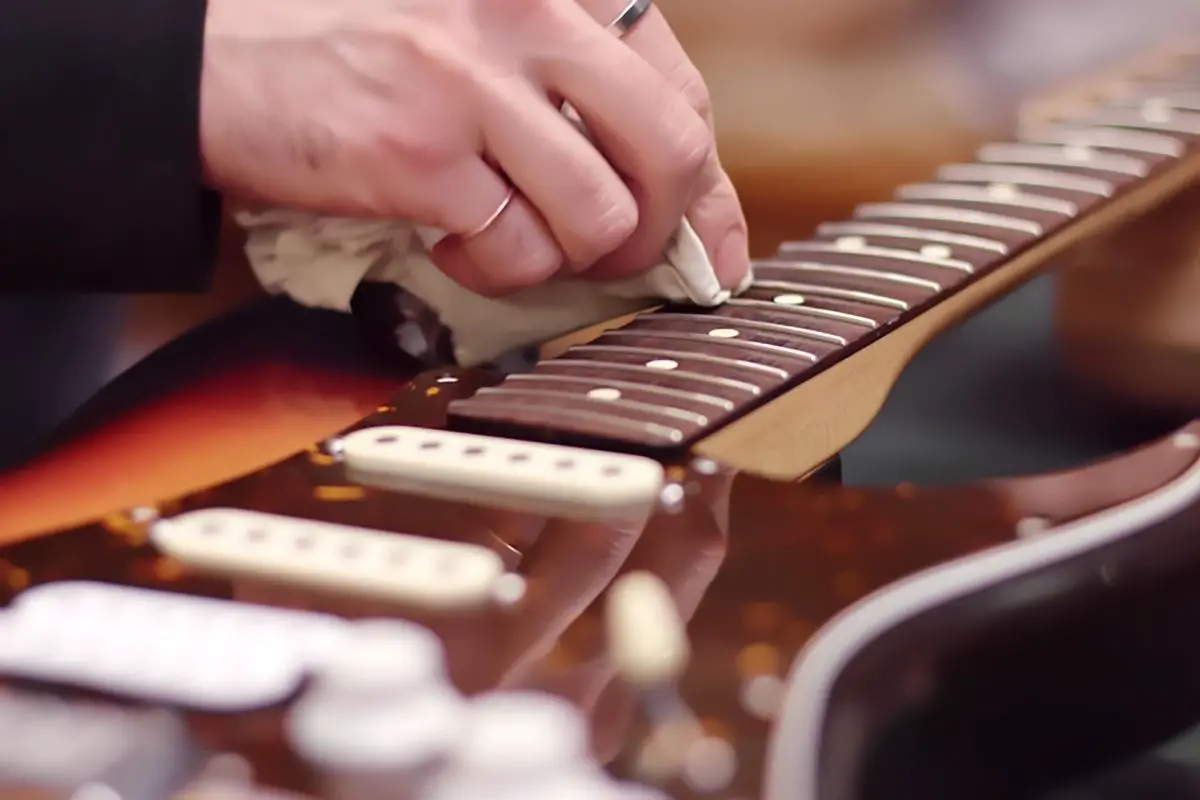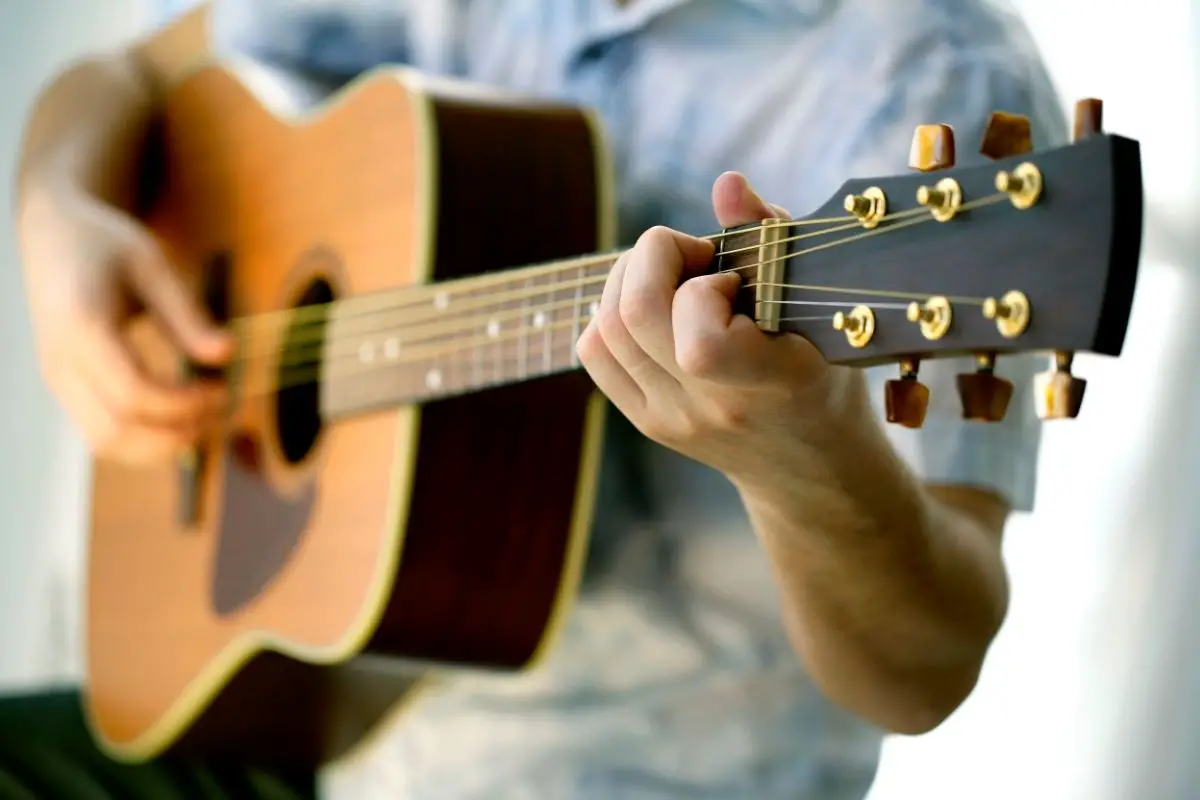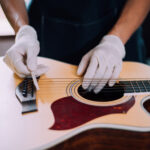One of the first things that manufacturers do to save money on new guitar models is to limit the colors and designs that they make.
This is great for your wallet, but less great if you want a standout guitar without the standout price.

But what can you do? You can always break out the paints and repainting guitar yourself.
All you have to do is assemble all the necessary ingredients and tools. Then, carefully disassemble all its parts, sand out the old finish, paint, finish and reassemble the parts back together.
Simple as this sounds, it’s quite a lengthy process that requires a lot of precision and patience.
Fortunately, It is super simple to learn how to repaint your guitar properly. From painting to refinishing, we will go through everything you need to know in this article.
Something To Keep In Mind
Before you embark on a guitar repainting project, you do need to keep in mind that finishing a guitar is very different from repainting other wood-based projects.
Repainting and refinishing a guitar to a high standard takes a lot of patience in order to achieve that coveted sleek and smooth look.
So, before you begin, you need to make sure that you have enough time set aside for this project. Don’t be surprised if working on repainting your guitar takes you a couple of weeks.
No matter how long it takes you to finish, don’t rush! We get it – you want to get back to playing your repainted guitar as soon as possible, but rushing will not give you the final, professional look you want!
Equipment
Repainting guitar properly will take a couple of pieces of equipment. You will need:
- Your guitar
- Orbital sander
- Sandpaper or sponge
- Sandpaper in fine, medium, and coarse grits
- Vacuum cleaner
- Cloths
- Mineral spirit
- White primer
- Spray cans or your paint of choice
- Spray gun if you choose to use spray cans
- Clear colored paint coats
- Dust mask and eyeglasses – safety first!
- Wire cutters
- Screwdrivers
- Allen wrench
- Soldering iron and solder
- Masking tape
Now you know what you need, follow these steps to get the best repaint job for your guitar.
How To Repaint A Guitar
When deciding to repaint a guitar, it’s very likely that you are looking for a personalised look. Maybe it is just a new paint that resonates with you. Or just some extra customisations with more colours and designs.
There are numerous available professionals that can do the repainting for you.
However, a professional repaint comes at a steep price tag. Even if you are just looking to repaint with no extravagant custom designs.
If you are looking to save some bucks, you can always take the DIY route. As mentioned before, this is a time-consuming endeavour.
But with patience as the below-detailed guide, you can repaint your guitar like a pro.
Disassemble The Guitar You Would Like To Repaint
You need to disassemble your instrument before you repaint it, so you don’t cause any unnecessary damage.
You can begin disassembly by removing the guitar’s strings. You can do this by clipping them away with a pair of wire clippers.
While this might seem excessive or even like sacrilege, you cannot repaint a guitar with the strings still on!
Because you need to remove the strings, you will almost definitely need to adjust your truss rod when you start re-assembling your guitar. This is just something to bear in mind as your progress with the paint job.
Remove The Neck
Once the guitar strings have gone, you need to take off the neck of your guitar.
Thankfully this is a pretty easy job as all you need to do is unscrew the screws and bolts on the back. With these gone, you should find that your guitar neck wiggles free.
You may have a glued-on guitar neck. If you do, the neck will not come away with a bit of wiggling or jiggling.
If it is glued you should not attempt to take it off. This will cause irrecoverable damage. Instead, leave the neck alone and repaint it at the end, so it matches the rest of your guitar.
Take Off The Hardware
With the strings and neck gone, it is time to take off the other pieces of hardware.
You will need to use a combination of screwdrivers and an Allen wrench to undo and remove the knobs, the bridge, strap buttons, pickups, the output jack, and the pick guard.
Keep in mind that some models of guitar will have wired output jacks and knobs. These guitars have wires running through holes in between each cavity. You will need to cut these wires to take away all the hardware.
If you do remove wires, make sure you make a note of where they were and what and how they were wired to.
You will need this information for reassembly. If you don’t have it to hand when you get to that stage, you won’t have a fully functioning guitar at the end.
Remove The Guitar Bridge Studs

This step is optional but is certainly something that should be seriously considered.
The bridge studs are the bits of your guitar that you will work on after taking away the hardware.
Some guitars have no bridge studs at all, but others can be quickly and easily unscrewed and removed from your instrument.
Be mindful if you do decide to have a go at taking out the bridge studs. Some are screwed on and super easy to take off, but others will be hammered into place.
Remember – removing the bridge studs is optional, but there are some tricks that you can use if you are particularly desperate to get rid of them.
Heating up the wood with a soldering iron is a good option. This will warm up the studs and then, when they have cooled down, the metal will contract and be a little easier to remove.
However, do not use pliers to yank them out. This will cause unsightly damage to your guitar.
Layout Your Hardware
Once you have taken everything off, make sure that you set everything aside in a sensible and organized manner.
You can either lay everything out on a surface that you know will be undisturbed while you work on your guitar, or you can put everything into little bags that are labeled.
Repainting your guitar can take up to a few weeks or months, so you need to make sure that you have everything you need when you are finished!
Keeping organized and labeling everything will reduce the likelihood of you losing something vital to the functioning of your guitar!
Remove Old Finish
You can now move onto the next stage of guitar prep and remove the old finish by gently sanding. We recommend that you follow one of two methods.
You can either ‘rough up’ the existing finish on your guitar enough that it will take a coat of paint, or you can sand until all the finish is removed.
You need to remove all the existing finish and paint if you plan on staining your guitar or painting with a translucent paint.
You will also need to do this if you want to repaint your guitar in a lighter color. Removing all the existing finish is important as it will affect the final look of your guitar.
If, however, you plan on painting your guitar a deeper color you only need to rough up the finish enough that the guitar will take the paint. Anymore and you are wasting your time.
While sanding, remember that guitar makers do not use thick coats. Thick coats of paint affect the integrity of sound that the guitar produces.
This means that you should sand carefully and gently – this will be enough to remove the thin layers of paint and finish.
Orbital Sander
Now you can break out the power tools! We recommend using an orbital sander to remove the finish from the back of your guitar.
Use some coarse sandpaper to sand the big, flat areas of your guitar and work in smooth and circular strokes.
Don’t use a paint stripper at any point in the guitar repainting process! The paint stripper is highly toxic and very messy.
The majority of paint strippers available don’t even have the ability to remove the choice ingredient – hard polyurethane – for most guitar manufacturers.
Sand By Hand
For the smaller parts of your guitar, like the edges, you will need to sand by hand. You will also need to sand by hand over any areas that the orbital sander missed.
A bit of elbow grease, a sand sponge, and some coarse sandpaper should be enough to remove any finish on the edges or anywhere that a sander couldn’t reach.
Fine Grit Sandpaper

With all the finish gone, you can now work on smoothing out the body of your guitar. This requires finer sandpaper – the finer the sandpaper, the smoother the final result.
You may find it easier to gradually work down the grit of your sandpaper. Begin with medium, then move on to fine. This does take a little longer but will give you the best results.
Clean Up The Dust
The sanding has now finished – thank heavens! Now you can clean up all the mess that you have made by removing your guitar’s finish.
We recommend using a vacuum cleaner with a hose attachment. You could also use a can of compressed air to blow away any sawdust.
Once you have cleared away the bulk of the debris, go over the area with a clean but damp cloth. This will grab onto any remaining dirt.
Grain Filler
If you like the distressed, shabby chic, unfinished look, you can skip this step.
You now need to cover your guitar with grain filler. Grain filler is an essential step when working with mahogany or other porous woods as it will even out the surface that you are going to be painting on.
We recommend an oil-based or water filler for guitar repainting projects.
Purchase a filler that is as close to the final finish or color of your guitar as possible. You can even get wood filler that is manufactured especially for guitars.
Mineral Spirits
Allow the grain filler to set, per the manufacturer’s instructions. Once this is done you need to remove all the oils that have built upon the body of your guitar.
Do this by wiping it down with a clean cloth and some mineral spirits.
Do not touch your guitar until you are certain that all the mineral spirits are 100% dry.
If you touch your guitar before the spirits have dried, the oil from your fingers will get back into the wood and ruin your repainted finish.
Repaint Prep
The final step you need to take before painting is preparing the area that you intend to paint in.
We recommend putting your guitar into a large box that is on top of something easily portable, like a tray.
Make sure you position the box so that it is on its side – you want to slide your guitar in rather than put it in from the top.
This way, all the paint will be kept inside the open box and not get all over your space.
You will also need to think about your surroundings. You will need to find an open area with nothing valuable nearby – you will be surprised where paint can end up!
Finally, think about ventilation. Most paints require a well-ventilated room because of the fumes.
Find Your Paint
Now for the fun! You need to decide on what paints you want to use for your guitar.
If you want a solid color for your repaint job, we recommend that you find a paint that is durable as it will be the easiest to get a professional-looking finish.
Look for ingredients like polyurethane or nitrocellulose for the best results.
Nitrocellulose is most often recommended and is readily available from the internet or from a car part store.
However, it can take an age to dry and this puts a lot of people off using it. If you are in a bit of a time crunch, we recommend going for polyurethane paints.
Not going for a painted look? Make sure that you pick up a water-based stain. Keep in mind that you will also need a clear coat to finish off your guitar repaint.
Again, we recommend that you opt for a clear coat with either polyurethane or nitrocellulose.
Oil-based stains and finishes are a popular alternative to water-based stains and a clear coat. Do some research to find out what is in your budget and what will work best for you.
On the subject of budget, think about considering a spray-on finish.
These are easy to use if you can get hold of them and eliminate the possibility of brush strokes or brush hairs when you have finished repainting.
Prime Time

You will find that your paint of choice adheres much better to your guitar when you have used a primer.
Multiple coats of primer will give you a very even base for you to start on, ensuring that your chosen paint is as true to its advertised color as possible.
Make sure that you do your research and purchase a primer that is suited for the type of paint that you are going to use.
Remember – thick coats can distort the sound that your guitar will eventually make when you play it. Two or three thin coats of your chosen primer will be far better for your guitar than one thick coat.
Look At Your Surroundings
Before you break out the paints, take a moment to look around. You need to paint in a dust-free area so that no flecks can get stuck to your guitar as you paint. This could ruin your guitar’s final appearance.
Painting outside may also not be a great idea as many species of bug are attracted to the smell of fresh paint. A creepy-crawly on your instrument will definitely ruin your guitar’s appearance!
So, we recommend painting inside in an open room. This will help make sure that you are painting in a ventilated area to avoid a dangerous concentration of paint fumes in the air.
Goggles may also be necessary if you are using particularly potent paint.
Get Painting
Chosen spray paint? Make sure you are working in thin and even layers. You need to leave plenty of time between spraying to make sure that the paint has the chance to fully dry.
If you are painting on a clear layer, you need to make doubly sure that the colored paint has dried.
We recommend leaving your guitar alone for a week after the final layer of colored paint before painting on the clear layer.
Get Staining
If you have chosen a stain, you will likely need to wet your guitar before you can apply your chosen stain.
The wetness will help make the stain move around your guitar more easily and help avoid any potential marks or blemishes.
For the best results, always follow the instructions provided by the manufacturer. Continue layering your chosen stain until you have the color and pigment density that you like.
Clear Coat
It is generally recommended that you apply a clear coat to seal in your chosen stain or paint color. You need to make sure that you leave it at least a week before you add the clear coat.
As mentioned before, we recommend a nitrocellulose-based coat at this stage. You still need to work in thin coats with as little product as possible and add in a second thin layer if necessary.
This will help keep you working neatly and will not have any effect on the tonal quality of your guitar when you have finished.
Want a hyper-shiny finish? You may be applying a dozen or more coats!
You need to make sure that you are leaving enough time for the product to dry between layers, no matter how many you have applied. Taking a week-long break every now and again may be necessary.
Polish Your Guitar
Use the wet sanding technique – don’t dry sand!
Wet sand the fully dried and hardened finish with fine-grit sandpaper, then a more coarse grit.
We recommend moving up in the following pattern to keep your sanding even: 400 grit, 600 grit, 800, 1000, 1200, 1500, and then finally 2000 grit sandpaper.
You need to work meticulously at this stage. Do not skip any imperfections in your guitar’s finish. This includes pits, dimples, bumps, scratches, marks, etc. If you leave them now you will not be able to get rid of them later.
While you are sanding, you need to make sure that you are not sanding all the way through the layers of clear coat you have applied.
You should never expose the repainted or re-stained layer. This means you must be particularly careful around areas where it is natural for less clear coat product to collect, like the edges.
Reassembly
Once you have sanded, it is time for you to put your guitar back together again. You need to find all the hardware that you safely stowed away all those weeks ago!
Take your time to re-familiarize yourself with your guitar’s hardware to make sure that you are feeling confident about bolting and screwing everything back into place.
It is at this stage that you will need to solder together any wires that you snipped to disassemble your guitar. In the mood for some customization?
Use this opportunity to upgrade any cheap or low-quality components with some better ones.
You can also use this time to upgrade your pick guard.
Finishing

Once all the hardware is screwed and bolted back into place, it is time to do the finishing steps of this repainting process.
Clean your guitar and give it a final shine with your favorite guitar polish. Now all you need to do is hook up some guitar strings, tune it up, and get playing!
Hot Tips
Here are some final safety considerations before you embark on this repainting journey with your guitar.
We do not usually recommend using a chemical paint stripper to remove paint from your guitar. It is dangerous to work with and highly toxic and carcinogenic.
Besides this, it can be difficult to control and may damage your guitar in such a way that it impacts the tonal sound of your guitar when played.
When sanding, be sure that you use all the appropriate safety equipment. Goggles and a dust mask are a must!
Lots of dust from chemical paint layers and clear coatings will be produced during a guitar repainting project – you don’t want any of it in your lungs!
Final Thoughts
Want to upgrade your guitar? Why not give it a repaint! This is a fantastic way to add some flair back to your instrument and update it so that it suits you and your style.
Follow these steps to get the best results in your repaint job. Be sure to follow all the manufacturer’s instructions on your chosen paint or stain, as well as for the final clear coat layer.
Happy painting!
Frequently Asked Questions
How Long Does It Take To Repaint A Guitar?
You can expect a repainting project to take anything from a couple of days to several weeks, depending on what techniques and products you decide to use.
Whatever products you decide to use, make sure that you leave enough drying time between layers. This drying time is what can make some repainting projects take so long.
Is Repainting A Guitar Expensive?
Doing a DIY painting job for your guitar is most definitely the cheaper option. That said, you can still expect to pay around $200 for paints, finishes, and equipment.
If you are unsure at any point of the repainting process, we of course recommend a trip to your local guitar shop for a professional to help.
Is My Guitar Worth More Now It’s Been Repainted?
Unfortunately, any repainting jobs for your guitar will only increase its sentimental value. You can expect a repaint job to take around 50% off your guitar’s value, no matter how well you do it!
Can You Repaint A Guitar Without Taking It Apart?
Technically, yes, you can repaint a guitar without taking it apart. As long as the wires are long enough to get out of the way of your paintbrush then you don’t strictly need to take all of your guitar apart.
That said, we most definitely recommend taking it apart!
Is It Difficult To Repaint A Guitar?
Repainting a guitar to a high standard is not necessarily difficult, the problem is more that people get frustrated with the long drying times or skip necessary steps.
A lack of patience is a surefire way to end up with untidy or less than excellent results.
Do I Need To Sand My Guitar Before I Paint It?

You do not need to get rid of all the guitar’s existing finish before repainting it, but, at the very least, you need to scratch up this layer enough that your new paint layers can easily adhere.
Fully sanding your guitar will give you the most even and professional-looking finish when you are done. Full sanding is also necessary if you want to stain your guitar rather than paint it a bold color.
Does Painting A Guitar Change Its Sound?
Repainting your electric guitar will not have a noticeable effect on its sound when you have finished your painting project.
This is because electric guitars generate most of their sound from the amps or pickups – not the body of the guitar.
Acoustic, on the other hand, are a little more sensitive. Whatever type of guitar you choose to work with it is always best to work in thin layers.
Can You Use Acrylic Paints On A Guitar?
Yes, acrylic paints are perfectly safe to use on either acoustic or electric guitars. However, acrylic paints are not very durable, so it is essential that you take the necessary steps in order to preserve the paintwork on your guitar.
This means that you need to properly prepare your guitar before you use the paints and use a good quality finishing layer. This will help seal in the paints, so they don’t flake off.
Can I Just Paint Over My Guitar?
Sure, if you want! If, however, you want a professional or sleek finish we recommend that you follow the steps above to properly prepare your instrument.
What Paints Can I Use On My Guitar?
You can technically use any type of paint on your guitar as long as you prep and finish it off properly.
A guitar with a lacquer finish will require lacquer paint for the best results. Similarly, an enamel finish guitar will work best with an enamel finish.
Make sure you do your research, so you know what types of products you need.
How Much Is A Custom Guitar Paint Job?
The steep prices of a professional custom guitar paint job are what make many people turn to DIY repainting guitar in the first place.
A professional repaint for your guitar will start off at around $200. A repaint with more input from the client can easily hit the $600 mark, with many renowned guitar painters charging well above this.
Keep in mind that you are not just paying for the products or equipment – you are paying for the artist’s time and their experience.
It is very possible to paint your guitar at home, you just need a lot of patience and be able to follow instructions well.
Can You Paint A Guitar With A Paintbrush?
There are a good deal of different paint application techniques that you can use – a paintbrush is just one of them.
One downside of using a paintbrush is that you may end up with streaks or brush strokes in the paint.
You can avoid these by doing the proper priming steps for your guitar and using even layers of paint. Keep these layers thin for the easiest application.
If you enjoyed this article, you might enjoy our post on ‘Drop D Tuning: How To Tune Drop D?’.

My name is Howard Matthews and I have been playing the guitar since I was knee-high. My parents like to joke that I was pulling the strings even before I was born. In fact, one of my earliest memories is sitting on the couch with my dad’s guitar, wreaking havoc on the chords.
Now, 40 years later, I can attest that I play them much better than I did back then. I have followed in the footsteps of both my parents – much to their delight – and have been the main guitarist in my band for the best part of three decades.
Music has always been my passion, and until recently my life has been so consumed with it that I haven’t had a moment to have a breath (and I wouldn’t have it any other way)!








